美国次贷危机何时见底 subprime mortgage crisis
- 格式:pdf
- 大小:27.56 KB
- 文档页数:5
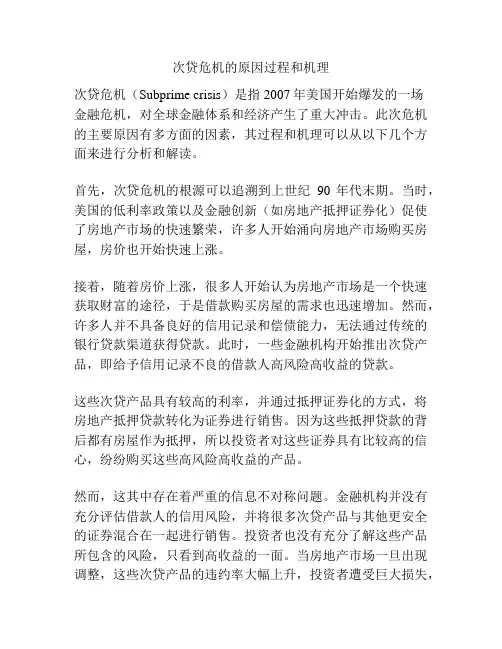
次贷危机的原因过程和机理次贷危机(Subprime crisis)是指2007年美国开始爆发的一场金融危机,对全球金融体系和经济产生了重大冲击。
此次危机的主要原因有多方面的因素,其过程和机理可以从以下几个方面来进行分析和解读。
首先,次贷危机的根源可以追溯到上世纪90年代末期。
当时,美国的低利率政策以及金融创新(如房地产抵押证券化)促使了房地产市场的快速繁荣,许多人开始涌向房地产市场购买房屋,房价也开始快速上涨。
接着,随着房价上涨,很多人开始认为房地产市场是一个快速获取财富的途径,于是借款购买房屋的需求也迅速增加。
然而,许多人并不具备良好的信用记录和偿债能力,无法通过传统的银行贷款渠道获得贷款。
此时,一些金融机构开始推出次贷产品,即给予信用记录不良的借款人高风险高收益的贷款。
这些次贷产品具有较高的利率,并通过抵押证券化的方式,将房地产抵押贷款转化为证券进行销售。
因为这些抵押贷款的背后都有房屋作为抵押,所以投资者对这些证券具有比较高的信心,纷纷购买这些高风险高收益的产品。
然而,这其中存在着严重的信息不对称问题。
金融机构并没有充分评估借款人的信用风险,并将很多次贷产品与其他更安全的证券混合在一起进行销售。
投资者也没有充分了解这些产品所包含的风险,只看到高收益的一面。
当房地产市场一旦出现调整,这些次贷产品的违约率大幅上升,投资者遭受巨大损失,金融市场信心受到严重打击。
次贷危机的危机传导过程主要体现在金融机构之间的相互关联。
一旦一家金融机构遭受损失,其它机构可能面临追加资本或债务违约的压力。
这种关联效应会导致信心危机蔓延,整个金融体系陷入严重的流动性危机。
而这种流动性危机进一步导致全球金融体系的信任崩溃,银行之间的互信关系被削弱,金融机构纷纷陷入困境,甚至出现破产。
次贷危机的机理主要涉及资本市场的失灵和金融监管的问题。
首先,资本市场对次贷产品的评估存在严重的信息不对称,金融机构没有充分披露风险,投资者没有充分了解产品风险。

美国次贷危机(subprime crisis)又称次级房贷危机,也译为次债危机。
它是指一场发生在美国,因次级抵押贷款机构破产、投资基金被迫关闭、股市剧烈震荡引起的金融风暴。
美国“次贷危机”是从2006年(丙戌年)春季开始逐步显现的。
在2006年之前的5年里,由于美国住房市场持续繁荣,加上前几年美国利率水平较低,美国的次级抵押贷款市场迅速发展。
随着美国住房市场的降温尤其是短期利率的提高,次贷还款利率也大幅上升,购房者的还贷负担大为加重。
同时,住房市场的持续降温也使购房者出售住房或者通过抵押住房再融资变得困难。
这种局面直接导致大批次贷的借款人不能按期偿还贷款,银行收回房屋,却卖不到高价,大面积亏损,引发了次贷危机。
2007年8月次贷危机席卷美国、欧盟和日本等世界主要金融市场。
这场危机导致过度投资次贷金融衍生品的公司和机构纷纷倒闭,并在全球范围引发了严重的信贷紧缩。
美国次贷危机最终引发了波及全球的金融危机。
2008年9月,雷曼兄弟破产和美林公司被收购标志着金融危机的全面爆发。
随着虚拟经济的灾难向实体经济扩散,世界各国经济增速放缓,失业率激增,一些国家开始出现严重的经济衰退。
2011年1月10日,国际清算银行在巴塞尔召开成员央行行长双月例会及全球经济会议,分析全球经济形势。
全球经济会议主席欧洲央行行长特里谢表示,世界经济已走出危机阴影,全球经济复苏已经确立。
钜丰金业友情提示:投资有风险,入市需谨慎!。

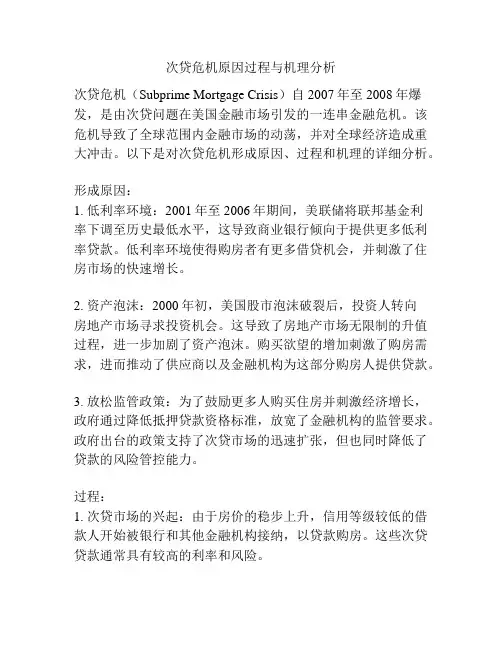
次贷危机原因过程与机理分析次贷危机(Subprime Mortgage Crisis)自2007年至2008年爆发,是由次贷问题在美国金融市场引发的一连串金融危机。
该危机导致了全球范围内金融市场的动荡,并对全球经济造成重大冲击。
以下是对次贷危机形成原因、过程和机理的详细分析。
形成原因:1. 低利率环境:2001年至2006年期间,美联储将联邦基金利率下调至历史最低水平,这导致商业银行倾向于提供更多低利率贷款。
低利率环境使得购房者有更多借贷机会,并刺激了住房市场的快速增长。
2. 资产泡沫:2000年初,美国股市泡沫破裂后,投资人转向房地产市场寻求投资机会。
这导致了房地产市场无限制的升值过程,进一步加剧了资产泡沫。
购买欲望的增加刺激了购房需求,进而推动了供应商以及金融机构为这部分购房人提供贷款。
3. 放松监管政策:为了鼓励更多人购买住房并刺激经济增长,政府通过降低抵押贷款资格标准,放宽了金融机构的监管要求。
政府出台的政策支持了次贷市场的迅速扩张,但也同时降低了贷款的风险管控能力。
过程:1. 次贷市场的兴起:由于房价的稳步上升,信用等级较低的借款人开始被银行和其他金融机构接纳,以贷款购房。
这些次贷贷款通常具有较高的利率和风险。
2. 金融创新工具的使用:为了将高风险次贷转化为投资组合,金融机构开始使用创新的金融工具,如担保债券、信贷衍生品等。
这些工具根据次贷的信用等级划分成为不同的投资等级,吸引了全球范围内的投资者。
3. 市场崩溃:次贷市场开始出现问题,购房者开始无法按时偿还贷款。
由于债务违约的风险增加,金融机构开始不再信任和买入这些次贷相关资产。
这导致了次贷市场的崩溃和金融市场的动荡。
机理:1. 层层抵押与杠杆:由于次贷市场存在较高的风险,金融机构通常将次贷贷款打包成担保债券,然后通过报销衍生品的方式进一步间接投资。
这滋生了一个层层抵押和杠杆的系统,一旦次贷市场崩溃,整个金融体系都会受到影响。
2. 信息的不对称:次贷市场中的许多贷款借款人并未提供准确或完整的财务信息,导致了信息的不对称。


财政金融名词解释汇总次贷危机(subprime mortgage crisis)又称次级房贷危机,也译为次债危机。
它是指一场发生在美国,因次级抵押贷款机构破产、投资基金被迫关闭、股市剧烈震荡引起的金融风暴。
它致使全球主要金融市场出现流动性不足危机。
美国“次贷危机”是从2006年春季开始逐步显现的。
2007年8月开始席卷美国、欧盟和日本等世界主要金融市场。
次贷危机目前已经成为国际上的一个热点问题。
宏观调控宏观调控:指政府为实现宏观( 总量) 平衡,保证经济持续、稳定、协调增长,而对货币收支总量、财政收支总量和外汇收支总量的调节与控制;由此扩展开来,通常把政府为弥补市场失灵采取的其他措施也纳入宏观调控的范畴。
在社会主义市场经济条件下,调控的主要目标是:经济稳定增长,重大经济结构优化,物价总水平基本稳定,充分就业,公正的收入分配,国际收支平衡等。
物价通常所说的物价其实就是生产价格,而生产价格是由部门平均生产成本加上社会平均利润构成的价格。
生产价格就是价值的转化形态。
价格是商品交换的产物。
价格是一个历史范畴,是随着商品交换的产生而产生、发展而发展的。
价格是交换双方利益的集中体现。
价格变动能够引起交换双方经济利益的此消彼长,即价格具有利益的消长性。
物价指数是反映计算期销售或购进的全部商品价格总水平比基期水平升降变动程度的相对数,通常以计算期(年度、季度或月度)与基期(某年度、季度或月度)相对比,以百分数表示。
</P< p>物价指数是经济指数中比较复杂的一种相对数。
按包括商品种类不同,分为单项商品价格指数、商品类别指数和总指数。
按采用基期的不同,分为环比物价指数(以上一期为基期)、年距环比物价指数(以上年同期为基期)、定基物价指数(和固定时期比较)。
按商品的种类和流通环节区分,有工业品出厂价格指数,农副产品收购价格指数、批发物价指数、零售物价指数、服务项目价格指数、职工生活费用价格指数、工农业商品的综合比价指数。
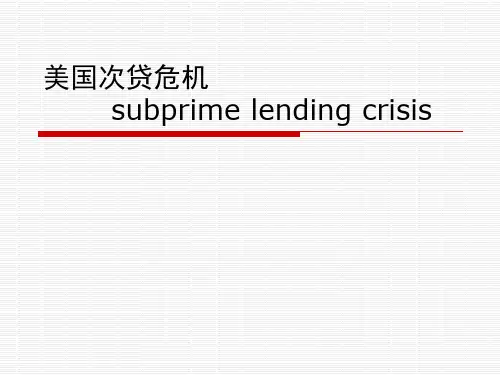
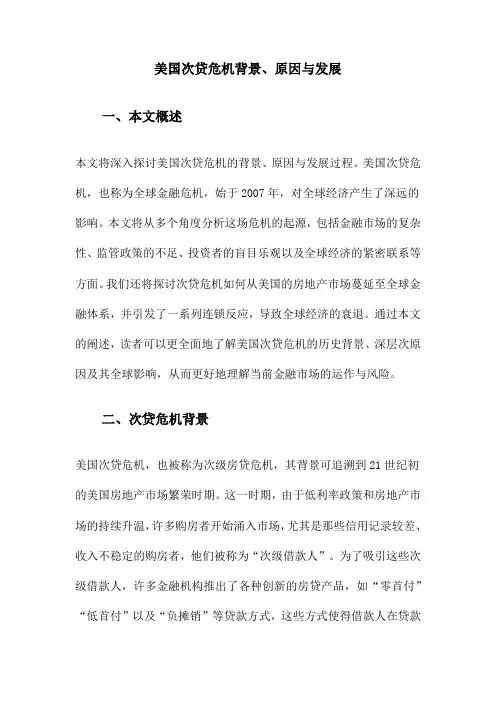
美国次贷危机背景、原因与发展一、本文概述本文将深入探讨美国次贷危机的背景、原因与发展过程。
美国次贷危机,也称为全球金融危机,始于2007年,对全球经济产生了深远的影响。
本文将从多个角度分析这场危机的起源,包括金融市场的复杂性、监管政策的不足、投资者的盲目乐观以及全球经济的紧密联系等方面。
我们还将探讨次贷危机如何从美国的房地产市场蔓延至全球金融体系,并引发了一系列连锁反应,导致全球经济的衰退。
通过本文的阐述,读者可以更全面地了解美国次贷危机的历史背景、深层次原因及其全球影响,从而更好地理解当前金融市场的运作与风险。
二、次贷危机背景美国次贷危机,也被称为次级房贷危机,其背景可追溯到21世纪初的美国房地产市场繁荣时期。
这一时期,由于低利率政策和房地产市场的持续升温,许多购房者开始涌入市场,尤其是那些信用记录较差、收入不稳定的购房者,他们被称为“次级借款人”。
为了吸引这些次级借款人,许多金融机构推出了各种创新的房贷产品,如“零首付”“低首付”以及“负摊销”等贷款方式,这些方式使得借款人在贷款初期只需支付较少的月供,但随着时间的推移,月供逐渐增加,最终可能导致借款人无法承受。
金融机构为了降低风险,将这些次级房贷产品进行打包,形成所谓的“次级抵押贷款债券”(Subprime Mortgage-Backed Securities, SMBS),并将其销售给全球的投资者。
由于这些债券通常具有较高的收益率,吸引了大量的投资者,包括养老基金、保险公司和银行等。
然而,这一切繁荣的背后隐藏着巨大的风险。
随着房地产市场的逐渐降温,房价开始下跌,许多次级借款人的房屋价值开始低于他们的贷款额度,形成了所谓的“负资产”。
这使得这些借款人无法再通过出售房屋来偿还贷款,从而陷入了违约的境地。
当大量的次级借款人违约时,就引发了所谓的“次贷危机”,并迅速蔓延至全球金融市场,引发了全球性的金融危机。
三、次贷危机原因美国次贷危机的原因是多方面的,既有宏观经济政策的影响,也有金融监管的缺失,还有市场参与者的过度投机行为。
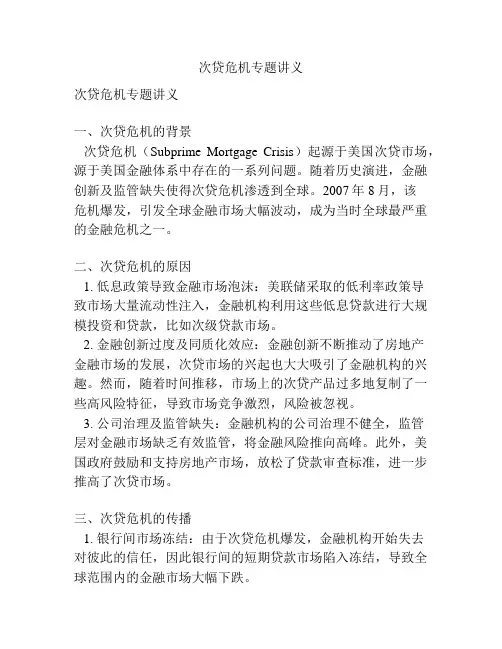
次贷危机专题讲义次贷危机专题讲义一、次贷危机的背景次贷危机(Subprime Mortgage Crisis)起源于美国次贷市场,源于美国金融体系中存在的一系列问题。
随着历史演进,金融创新及监管缺失使得次贷危机渗透到全球。
2007年8月,该危机爆发,引发全球金融市场大幅波动,成为当时全球最严重的金融危机之一。
二、次贷危机的原因1. 低息政策导致金融市场泡沫:美联储采取的低利率政策导致市场大量流动性注入,金融机构利用这些低息贷款进行大规模投资和贷款,比如次级贷款市场。
2. 金融创新过度及同质化效应:金融创新不断推动了房地产金融市场的发展,次贷市场的兴起也大大吸引了金融机构的兴趣。
然而,随着时间推移,市场上的次贷产品过多地复制了一些高风险特征,导致市场竞争激烈,风险被忽视。
3. 公司治理及监管缺失:金融机构的公司治理不健全,监管层对金融市场缺乏有效监管,将金融风险推向高峰。
此外,美国政府鼓励和支持房地产市场,放松了贷款审查标准,进一步推高了次贷市场。
三、次贷危机的传播1. 银行间市场冻结:由于次贷危机爆发,金融机构开始失去对彼此的信任,因此银行间的短期贷款市场陷入冻结,导致全球范围内的金融市场大幅下跌。
2. 信贷紧缩及流动性问题:次贷危机导致了全球范围内的信贷紧缩,金融机构对借贷者的信心下降,担心债务违约风险,因此开始严格审核并减少贷款,造成了流动性问题。
3. 全球金融市场动荡:次贷危机席卷全球,引发了全球范围内的金融市场大幅波动,股票市场暴跌,全球经济也受到严重冲击。
四、次贷危机的后果和教训1. 经济衰退和金融危机:次贷危机引发了全球范围内的经济衰退,失业率上升,房地产市场崩盘,股票市场大幅波动,全球经济陷入低迷状态。
2. 监管加强和金融改革:次贷危机揭示了金融监管的重要性,各国政府纷纷加强监管力度,修订金融法规,提升金融机构的风险管理能力,以避免类似危机再次发生。
3. 深化金融市场和巩固经济实力:危机发生后,各国政府认识到金融市场的深化和经济实力的巩固对于国家稳定发展的重要性,开始加大金融改革力度,加强金融体系的韧性。

次贷危机(subprime mortgage crisis)又称次级房贷危机,也译为次债危机。
它是指一场发生在美国,因次级抵押贷款机构破产、投资基金被迫关闭、股市剧烈震荡引起的金融风暴。
它致使全球主要金融市场出现流动性不足危机。
美国“次贷危机”是从2006年春季开始逐步显现的。
2007年8月开始席卷美国、欧盟和日本等世界主要金融市场。
次贷危机目前已经成为国际上的一个热点问题。
次贷的危机的机理。
次贷即“次级subprime 按揭贷款”(mortgage loan),“次”的意思是指:与“高”、“优”相对应的,形容较差的一方,在“次贷危机”一词中指的是信用低,还债能力低。
次级抵押贷款是一个高风险、高收益的行业,指一些贷款机构向信用程度较差和收入不高的借款人提供的贷款。
与传统意义上的标准抵押贷款的区别在于,次级抵押贷款对贷款者信用记录和还款能力要求不高,贷款利率相应地比一般抵押贷款高很多。
那些因信用记录不好或偿还能力较弱而被银行拒绝提供优质抵押贷款的人,会申请次级抵押贷款购买住房。
在房价不断走高时,次级抵押贷款生意兴隆。
即使贷款人现金流并不足以偿还贷款,他们也可以通过房产增值获得再贷款来填补缺口。
但当房价持平或下跌时,就会出现资金缺口而形成坏账。
次级按揭贷款是国外住房按揭的一种类型,贷给没多少收入或个人信用记录较低的人。
之所以贷款给这些人,是因为贷款机构能收取比良好信用等级按揭更高的按揭利息。
在房价高涨的时候,由于抵押品价值充足,贷款不会产生问题;但房价下跌时,抵押品价值不再充足,按揭人收入又不高,面临着贷款违约、房子被银行收回的处境,进而引起按揭提供方的坏帐增加,按揭提供方的倒闭案增加、金融市场的系统风险增加。
各国政府继续采取措施救据新华社北京10月15日电金融危机对世界主要经济体的影响日渐加深,美国、德国、英国等国家近日相继传出利空消息。
与此同时,其他国家继续采取措施应对全球金融市场动荡。
美国财政部14日公布的数据显示,2008财年美国政府财政赤字达到创纪录的4550亿美元,占美国国内生产总值的3.2%,接近上一财年的三倍。

次贷危机名词解释
次贷危机 (Subprime Mortgage Crisis) 是指 2007 年至 2008 年期间,由于美国次贷市场泡沫破裂,导致银行和金融机构遭受重大损失,并引发全球性的金融危机的事件。
在美国次贷危机之前,由于宽松的货币政策和低利率环境,许多借款人无法获得传统的住房贷款,因此,次贷市场应运而生。
次贷市场是指为那些信用等级较低、财务状况较差的借款人提供的贷款。
这些贷款通常被称为次级贷款(Subprime Loans) 或次级信用贷款 (Subprime Mortgages)。
然而,由于次贷危机中的借款人信用等级较低,银行和金融机构无法收回贷款,导致许多银行和金融机构遭受了巨大的损失。
此外,由于次贷危机引发了信用紧缩,导致许多借款人无法按时偿还贷款,这也对金融市场产生了深远的影响。
次贷危机的爆发引发了全球性的金融危机,导致许多国家的经济增长放缓,并引起了许多国家的政府采取紧急措施来稳定金融市场。
次级抵押贷款危机讲义次级抵押贷款(Subprime mortgage)危机是指在2007年至2008年间,美国次级抵押贷款市场崩溃的事件。
本文将着重讲解次级抵押贷款危机的原因、影响和教训。
一、次级抵押贷款的定义和特点次级抵押贷款是指向信用评级较低的借款人发放的贷款。
这些借款人通常具有较高的违约风险,因此贷款利率较高。
由于这些贷款风险较高,通常不符合传统的主流银行贷款标准,因此往往由次级抵押贷款机构或专门的次级贷款市场提供。
次级抵押贷款的特点是利率较高、还款期限较短、可贷额度较低,且通常要求借款人提供较高的质押资产作为担保。
二、次级抵押贷款危机的原因1. 高风险借款人的放贷过程:次级抵押贷款机构为了追求高额利润,对信用评级较低的借款人审查不严,过度放宽了贷款标准。
这导致了大量信用欠佳的借款人能够获得贷款,进一步增加了违约风险。
2. 金融衍生产品的泛滥:为了分散风险和增加利润,金融机构创造了许多金融衍生产品,如次级抵押贷款债券(subprime mortgage-backed securities)、信用担保证券(collateralized debt obligations,CDOs)等。
这些衍生产品通过将贷款打包成债券,并分散在各种投资者之间,从而将次级抵押贷款风险转移给其他市场参与者。
然而,这种分散风险的方法过于乐观,没有充分考虑次级抵押贷款市场的实际风险。
3. 泡沫经济和房地产市场:在2000年至2005年期间,美国房地产市场经历了一波繁荣时期,房价大幅上涨。
这导致了许多投资者将资金投入房地产市场,其中包括对次级抵押贷款的投资。
然而,这种泡沫经济和房地产市场的繁荣是不可持续的,最终导致了房价下跌和次级抵押贷款市场的崩溃。
三、次级抵押贷款危机的影响1. 金融机构倒闭和资本市场动荡:次级抵押贷款危机导致许多次级抵押贷款机构破产,进而对其他金融机构造成连锁反应。
一些大型投资银行和保险公司也因此遭受巨大损失,甚至濒临破产。
When Will US Subprime Mortgage Crisis End?Zhou Shijian,Senior Research Fellow, Center for US- China Relations, Tsinghua UniversityThere are three levels concerning borrowers’ credit in the US real estate mortgage market: Prime Mortgage Market, Mortgage Market and Subprime Mortgage Market. Based on borrowers’ credit index, 700 to 820 points is categorized to excellent, 600 to 700 good, 500 to 600 moderate and 300 to 500 poor. The last two categories comprise subprime mortgage, which is provided to borrowers having other debts and without high credit index and repayment prove. Compared to favorable mortgage provided to high-credited borrowers, the interests of subprime mortgage are higher. That’s why financial institutes provide mortgage to borrowers of lower credit rating. They always chase for maximum profits. In order to attract low incomers, financial institutes lower the threshold to subprime mortgage. People can borrow money with no down payment and only pay interests for the first three years. The policy stimulates rapid expansion of subprime mortgage market.In 2003, the total value of subprime mortgage was only 300 billion US dollars. The number reached 2,000 billion in 2006. Forty percent of new house buyers relied on subprime mortgage in 2006.The interests of the first two years remains low, but as time goes by, the interests of subprime mortgage increase accompanying benchmark rate rising. In 2003, the repayment interest was 3 percent. And it raised above 12 percent three years later. For buyers with low incomes, they resort to subprime mortgage for they expecting housing prices to rise despite heavy economic burden resulted from high interests – the interests of subprime mortgage are usually 30 percent higher than those of mortgage. While financial institutes don’t keep the high-risk subprime mortgage in hand. They turn those mortgages to stocks and securities and sell them to other institutes and public investors. Those Wall Street securities traders even create various complicated financial derivatives, including house mortgage in Collateralized Debt Obligations and sell to risk-prone investors after being labeled with high rates. Subprime mortgage and its derivatives transfer from hand to hand in merely several months. Nobody knows who will be the last possessor and how many he will possess. The snowball of such financial derivatives become bigger and bigger.Two elements may be blamed for subprime mortgage crisis: low interests and surging housing prices. Alan Greenspan cut deposit interest for 13 times since January 30, 2001. The rate decreased to 1.0 at the end of June 2003 from 6.5 at the first place. From 2002 to 2004, low interest boosted real estate market for three consecutive years. According to statistics, the increase rate of housing prices was 5 percent higher than that of GDP in the same period and the housing prices rose by about 80 percent. To avoid inflation and overheating economy, Greenspan started increasing interest on June 30, 2004. After the 17th increase, the rate reached 5.25 on June 29, 2006. At the same time, the mortgage interests, especially subprime mortgage rate surged from 3 percent to more than 12 percent. When the housing prices move upwards, people can raise a mortgage on their houses, but when the trend is down, lowincomers are faced with mortgage defaults. Their houses will be confiscated and auctioned if they fail to make their monthly payment in three months. That results in bad debts of lenders, bankruptcy of banks and finally leads to crisis of financial market. Since the end of 2006, with decreasing housing prices house owners found their losses increasing. So did the bad debts. The average housing price fell by 17.8 percent in July 2008. In some states, such as California, Florida and Las Vegas it fell by more than 30 percent. The plummet of real estate trade and puncture of housing bubble reflected inevitable crisis.Several years ago, subprime mortgage and its derivatives were praised as “innovation to financial derivatives”. It’s known to all that financial innovations are lifeline to the Wall Street. Warren Buffett said that subprime mortgage was a poisonous wine brewed by American financial industry itself. But American financial institutes also sell subprime mortgage to other parts of the world, such as Europe, Japan, China and India.On March 12, 2007, New Century Financial Corporation, the second biggest mortgage institute in America filed a bankruptcy petition and lifted the curtain on the crisis. However, that didn’t make the US government alert. On May 17, Federal Reserve chief Ben Shalom Bernanke told the Congress that the subprime mortgage crisis wouldn’t have severe impact on other financial sectors or the whole system. The crisis had been under control. But as the crisis emerged, people realized that the subprime mortgage crisis was more than bad debts.The crisis forced Federal Reserve to abandon the currency contract policy conducted in the last two years and cut base rate by 0.5 percent at the regular meeting on September 18. But the measure was half a year late. American economy declined enormously in the fourth quarter with an increase rate of merely 0.6 percent. On January 21 and 22, 2008, the New York stock market witnessed two “Black Days” with consecutive slumps. The American economy steersman had to cut interest rate by 1.25 percent (0.75+0.5) twice from January 22 to 29.The congress also reacted quickly. On February 13, President Bush approved an emergent fund for drawback of 168,000 million US dollars and required the cheques to be mailed to tax payers before July 11. A family with four members will have a drawback of 1,800 US dollars. Federal Reserve also pour 160,000 million US dollars into big- and medium- sized banks and institutes with heavy losses. Another 200,000 million US dollars poured into the market on March 11. Federal Reserve also asked the Group of Ten to help local banks and save the market. By the end of April, Federal Reserve had offered 782,700 million US dollars of capital flow to the financial market. And the loss of 12 American financial institutes reached 153,600 million US dollars by the end of June 2008.Citibank lost 42,900 million US dollars, Merrill Lynch 37,100 million, Bank of America 15,100 million, Morgan Stanley 14,100 million, JP Morgan 9,800 million, Washington Mutual (WaMu) 9,100 million, Lehman Brothers 8,200 million, Wachovia Corporation 7,000 million, Goldman Sachs 3,800 million, Wells Fargo 3,300 million, Bear Stearns 3,200 million, National City 3,100 million.There are three to four hundred medium- and small- sized banks stuck in the crisis. By that time, subprime mortgage finally triggered financial crisis. According to International Monetary Fund (IMF), the total known loss of financial institutes around the world reached 395,800 million US dollars and the estimated loss 995,000 million US dollars.The institutes with heavy losses outside the US include: UBS 38,200 million US dollars, HSBC 19,500 million, IKB 15,900 million, Royal Bank of Scotland 15,200 million, Credit Suisse 9,600 million, Crédit Agricole 8,300 million, Deutsche Bank 7,600 million, HBOS 7,000 million, Bayerische Landesbank 6,700 million, Fortis 6,600 million, Canadian Imperial Bank of Commerce 6,500 million, Barclays Bank 6,300 million, Societe Generale 6,200 million, Mizuho Financial Group 6,000 million, ING 6,000 million. Three state-owned banks in China bought subprime bonds of 8,800 million US dollars. (Bank of China 4,990 million, China Construction Bank 2,600 million and Industrial and Commercial Bank of China1,200 million.)As a result, the economic growth rate slowed down in the fourth quarter of last year. Since last fall, Federal Reserve continuously adjusted its predict of 2008 American economic growth. The predicted growth rate was 1.8-2.5 last October, 1.3-2.0 last February and 0.3-1.2 last May. On April 9, IMF predicted that the growth rate was 0.5, the worst since 1991. And the global growth rate was merely one percent. The Bush administration has conducted three measures accordingly: large-scaled tax rebate, financial rescue plan and interest rate cut – seven consecutive cuts from September 18 last year to April 30, and the rate reduced to 2.0 from 5.25. However, the measures won’t be effective until the second half of the year and the rebound is expected to appear in the fourth quarter.“A recession is possible,” said Ben Shalom Bernanke in his statement before the Joint Economic Committee on April 2. "It now appears likely that real gross domestic product (GDP) will not grow much, if at all, over the first half of 2008 and could even contract slightly…Clearly, the US economy is going through a very difficult period. "But he maintained that "we expect economic activity to strengthen in the second half of the year, in part as the result of stimulative monetary and fiscal policies."Bernake’s judgment was based on the hypothesis that the subprime mortgage crisis is approaching the end. But the fact seems to move in the opposite direction. The crisis broke out in the spring of 2007 and spread to the whole economic sector in July, 2007. Since then, the American market has experienced four shock waves, which indicated that the financial crisis is getting worse.Five financial institutes involved with subprime mortgage closed down during July and August 2007. Federal Reserve had to cut the rates from time to time. And the period from the end of 2007 to the beginning of 2008 witnessed financial giants such as Citibank, Merrill Lynch, Bank of America and Morgan Stanley trapped in huge losses. The great marketfluctuation forced Federal Reserve to cut the rates, again. In March 2008, Bear Stearns advised Federal Reserve that it would have to file for bankruptcy. Federal Reserve had to provide funding to Bear Stearns to avoid the sudden failure of one company leading to a chaotic market.The latest shock was the plummet stock prices of Fannie Mae and Freddie Mac. From the late June to July 15, the stock price of Fannie Mae lost 64 percent and that of Freddie Mac 68 percent. The two companies together possess 5,200 billion US dollars of housing loans, accounting for 43 percent of the total loans of 12,080 billion US dollars. That made the crisis worse. Moreover, it made a big lash to overseas investors.On July 11 and 23, the Congress approved the rescue plan of 300,000 million US dollars allocated to help borrowers and banks get through the difficult time. At least 400,000 thousand borrowers kept their houses. Bad debts and potential bankruptcies reduced considerably.Another big deal on July 11 was that Federal Deposit Insurance Corporation took over Indy Mac. The regional bank and mortgage institute reopened on July 14 under the new name of Indy Mac Federal Bank. Indy Mac had declared bankruptcy after 11 consecutive business days of bank runs of 1.3 billion US dollars. Indy Mac was the second big financial institute falling down in the US history.The newly released statistics show that American economy will face the threat of inflation before the recession ends. The inflation index in 2007 was 2.9 and the number in May and June this year both 4.2. Along with oil and food prices hike, economists predicted that the CPI of August would rise to five percent. Federal Reserve is trapped in a dilemma: Cutting rates will result in inflation and increasing rates will hinder economic growth.Subprime mortgage and financial crisis impaired customers’ confidence. According to a recent survey by Nielson, 63 percent of customers cut down expenses, 78 percent reduced shopping and 52 percent ate outside for fewer times. People tend to buy discounted goods with coupons.Economists predicted the difficulty would last until next year. And people have to live a frugal life. When I was in America, I found few people in some shopping malls. You don’t have to wait at the cashier counter. Most department stores offered quite favorable discounts as much as 50 to 75 percent.Overseas shoppers can enjoy a tax refund of 11 percent, higher than local consumption taxes. There were few visitors to Capitol Hill and Lincoln Memorial during the hot season of July and August. Some Americans drive to work in one car so as to save gas expenses. Banks tightened credit and mortgage due to bad debts. As we all know, Americans rely on credit and loans. The credit card department of the biggest savings and loan bank in America WaMu lost 1,750 billion US dollars in the second quarter. The cardholders’ debts reached averagely 8,400US dollars, almost eight times the figure eight years ago. Credit card consumption plays a key role in American economy. Consuming expense is the biggest momentum of the economy, accounting 72 percent of the annual GDP growth. The consumer confidence index revealed by Michigan University showed the number in July 2007 was 90.4, that in January of 2008 78.4, February 70.8, March 69.5, April 62.6, May 59.8, June 56.7 – the lowest since 1980 (the number of May 1980 was 58.7). And the retail sales of March were the lowest in the last 13 years.The unemployment rate of 2007 was 4.6 percent and the Federal Reserve predicted the rate would rise to 5.3. The rate in the first half of the year was 4.9 in January, 4.8 in February, 5.1 in March, 5.0 in April, 5.5 in May and June respectively. Rising unemployment rate will further impair consumption.The crisis leads to American economy contraction, consumption decrease and reduces capital flow of importers. According to the US Customs, the import from China increased 19.32 percent in the first quarter of 2007. The growth rate declined to 13.21, 9.41 and 7.14 percent in the next three quarters. The number was poorly 1.82 in the first quarter of this year, but it rebounded to 4.4 from January to May.On July 7, Bernanke said on the Federal Deposit Insurance Corporation Forum that the emergent financing for the Wall Street due in September would continue to 2009. He also promised to take more measures to maintain market stability. Paulson also said on July 20 that it would took months for American economy to resume rapid growth again.When will the crisis end? Nicholas Lardy(?), a senior research fellow at the Peterson Institute for International Economics maintained that the optimistic prediction was the summer of 2009. The more common idea is the end of 2009 and pessimists think it lasts until 2010. There are three signs of the end: the rebound of housing prices and consumer confidence index, and the decline of unemployment rates.Pieter Bottlier with the World Bank echoed his opinion.Another issue is how to rebuild consumers’ confidence. There are a lot of people waiting to purchase a house. They are watching the price trend and more accurately, the tendency of American economy. Maybe the result of presidential campaign will have positive impact on the economy.。